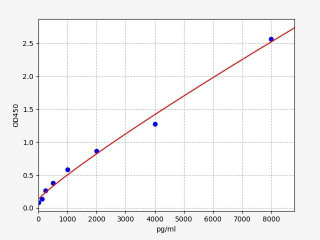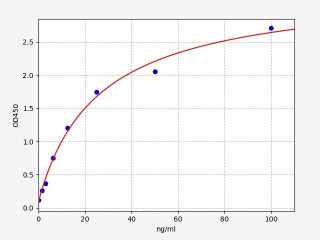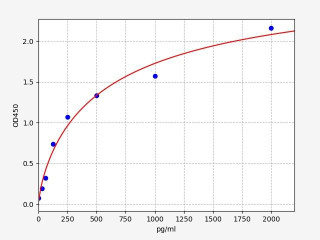Hepatocyte growth factor (HGF)
What is Hepatocyte Growth Factor?
Hepatocyte growth factor (HGF) is a cytokine that is mainly produced by the liver. HGF is a pleiotrophic cytokine that regulates cell growth, motility, and morphogenesis. The majority of HGF is produced by the liver, but it is also expressed in other organs, such as the kidney, pancreas, and intestine. HGF binds to its cognate receptor, c-Met, which is present on the surface of many types of cells. However, it has no measurable protease activity. Binding of HGF to c-Met leads to activation of multiple signaling pathways that promote cell proliferation, survival, migration, and differentiation.
Key Takeaways
- Hepatocyte Growth Factor (HGF) is a critical cytokine primarily produced by the liver, involved in cell growth, motility, and morphogenesis.
- HGF functions through binding to the c-Met receptor, activating pathways for cell proliferation, survival, migration, and differentiation.
- Structurally, HGF transitions from an inactive single-chain to an active two-chain form, integral for its biological activities.
- HGF's roles extend to tissue repair, regeneration, angiogenesis, and wound healing, showcasing its therapeutic potential in liver diseases, cancer, kidney injury, lung diseases, and neurodegenerative disorders.
Schematic of a Hepatocyte
What is the Structure of Hepatocyte Growth Factor?
Hepatocyte Growth Factor is produced as a preproprotein of 728 amino acids, with a signal sequence and both α- and β-chains. A single-chain HGF is generated between Arg494 and Val495 during cleavage of a signal peptide of the first 31 amino acids, giving rise to a two-chain mature HGF. Single-chain HGF is biologically inactive, and processing into the two-chain form is coupled to its activation. The α-chain of HGF consists of an N-terminal hairpin loop domain, a four-bladed β-propeller domain, and kringle domains. The β-chain contains a serine protease-like domain with a catalytic triad. The α-chain and β-chain are connected by disulfide bonds, forming a heterodimeric structure. Upon binding to its receptor, c-Met, HGF undergoes conformational changes that activate downstream signaling pathways, contributing to its biological functions in cell growth, tissue repair, organ development, and angiogenesis.
Functions of the Hepatocyte Growth Factor Receptor
HGF in Cell Growth and Proliferation
Hepatocyte Growth Factor exhibits a crucial role in promoting cell growth and proliferation. Acting as a potent mitogen, HGF stimulates cell division and proliferation in various cell types. It exerts its influence on hepatocytes, epithelial cells, endothelial cells, and cells of the immune system. Through its binding to the c-Met receptor, HGF activates signaling pathways that regulate cell growth, leading to increased cellular replication and expansion.
HGF in Tissue Repair and Regeneration
HGF plays a vital role in tissue repair and regeneration processes. Following tissue injury, HGF is released and acts as a signaling molecule to attract cells to the damaged area. It prompts the migration of cells, stimulates their proliferation, and promotes tissue healing. By facilitating the restoration of normal tissue structure and function, HGF contributes significantly to the repair and regeneration of damaged tissues.
HGF in Angiogenesis
HGF is closely associated with the process of angiogenesis, which involves the formation of new blood vessels. HGF promotes angiogenesis by inducing proliferation and migration of endothelial cells, the building blocks of blood vessel walls. By facilitating the growth of new vascular networks, HGF supports the physiological development of blood vessels as well as their formation in pathological conditions.
HGF in Wound Healing
In the complex cascade of wound healing, HGF plays a significant role. It stimulates the migration and proliferation of skin cells, aiding in the closure of wounds and the regeneration of skin tissue. By promoting the formation of granulation tissue, HGF facilitates the deposition of extracellular matrix and the development of new blood vessels, which are crucial components of the wound healing process.
Clinical significance of Hepatocyte Growth Factor
-
Liver Diseases: HGF has been studied extensively in the context of liver diseases, including liver fibrosis and cirrhosis. It has shown potential as a therapeutic target for promoting liver regeneration and reducing fibrosis.
-
Cancer: HGF and its receptor, c-Met, have been implicated in cancer development and progression. Aberrant HGF/c-Met signaling can contribute to tumor growth, metastasis, and resistance to therapy. Targeting HGF/c-Met signaling is being explored as a strategy for cancer treatment.
-
Kidney Injury: HGF has shown promise in the field of nephrology. It has been studied for its potential to protect against kidney injury, promote kidney regeneration, and improve renal function.
-
Lung Diseases: In pulmonary diseases such as acute lung injury, and chronic obstructive pulmonary disease (COPD), HGF has been investigated as a potential therapeutic agent for promoting lung repair and reducing fibrosis.
-
Neurodegenerative Disorders: HGF has shown neuroprotective and neuroregenerative properties, making it a subject of interest in the field of neurology. It is being explored as a potential treatment for neurodegenerative disorders such as Parkinson's disease and spinal cord injury.
HGF Related Kits
Interactions of Hepatocyte Growth Factor
Hepatocyte Growth Factor interacts with a variety of molecules and receptors, playing a complex role in cellular signaling. HGF primarily binds to its specific receptor, c-Met, initiating a cascade of intracellular events. This interaction triggers downstream signaling pathways, such as MAPK/ERK and PI3K/AKT, which regulate critical cellular processes including cell survival, proliferation, migration, and differentiation. Additionally, HGF can interact with other molecules in the extracellular environment, such as heparan sulfate proteoglycans, which may enhance its binding to the c-Met receptor or modulate its bioavailability. These intricate interactions of HGF with its receptor and other molecules are essential for the precise control of cellular responses and contribute to the diverse biological functions of HGF in cell growth, tissue repair, organ development, and angiogenesis.
Written by Lauryn McLoughlin
Lauryn McLoughlin completed her undergraduate degree in Neuroscience before completing her masters in Biotechnology at University College Dublin.
Additional Resources
Recent Posts
-
MHC Class I vs MHC Class II: Key Differences and Functions
Major Histocompatibility Complex (MHC) molecules are essential for immune recognition …22nd Nov 2024 -
Amino Acids: Functions, Roles, and Structures
Amino acids are the fundamental units of proteins, playing critical roles in virtually …22nd Nov 2024 -
Immunoglobulins: Structure, Function, and Clinical Importance
Immunoglobulins (Igs), also known as antibodies, are glycoproteins produced by B cells …20th Nov 2024




